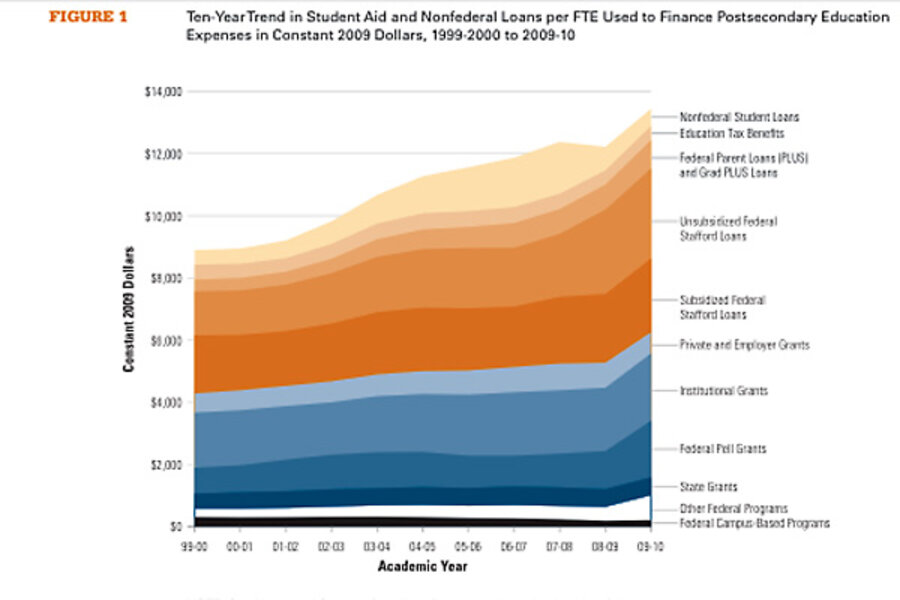SAT test creator: Don't let tuition hikes scare you
Loading...
The costs of attending college – tuition, room, board, fees, books – keep spiraling upward. Over the past decade, the published tuition and fees – the "sticker price" – rose 5.6 percent a year at public universities and 3.0 percent a year at private colleges, in constant dollars, the College Board reported Thursday. Just last year, in-state tuition jumped 7.9 percent at public universities, while private colleges showed a 4.5 percent increase.
That's the bad news.
The good news is that almost nobody pays sticker price anymore, thanks to $200 billion (yes, billion) in grants (federal, state, and private), federal loans, federal tax credits and deductions, and federal work-study for undergrads and grad students, according to Trends in Student Aid 2010. Private and state loans added another $8.5 billion.
"Despite rising prices," said Sandy Baum, independent policy analyst for The College Board and co-author of the studies, "after considering grant aid and tax benefits, on average students are paying less in tuition and fees than they were five years ago."
But that sticker price is a powerful deterrent for some.
"There are an awful lot of people who pay the sticker price or something very close to it," says Richard Vedder, director of the Center for College Affordability and Productivity, a not-for-profit research center in Washington, D.C. "People from affluent families going to private colleges are not going to get a huge tuition discount unless there’s something extraordinary in their academic record. The fact is, when you apply to school, you don’t know if you’ll pay $20 or $30 or $40 thousand until the school tells you what institutional financial aid they’ll provide."
Total aid to undergraduates increased 51 percent over the past decade, and aid to graduate students by 42 percent, in constant dollars. Graduate students often get left out of the student aid conversation, but they qualify for many of the benefits, as well.
In the 2009-10 school year, about 8 million undergrads and grad students received $400 to 500 apiece from tax benefits. Many fewer students benefited from institutional and private grants, but those made the biggest difference for students at high-priced private colleges.
Increases in grant aid and tax credits don't benefit all students, since most are targeted to low-income students and families, but they do help millions. This past year saw the largest increase in Pell Grant history – almost $10 billion – as 7.7 million students received $28.2 billion. Only about 25 percent of Pell Grant recipients demonstrated enough financial need to qualify for the maximum amount, now $5,350. The average Pell Grant award in 2009-10 was $3,646.
In 2009-10, the biggest sources of student aid besides Pell Grants were federal loans ($65.8 billion) and institutional grants ($26.0 billion). Altogether, these three sources accounted for 78 percent of all undergraduate student aid. Other sources included private and employer grants, state grants, federal work-study, federal tax credits and deductions, and non-Pell federal grants.
Federal contributions to student aid have shown the biggest growth, the report showed. In 1999-2000, federal grants comprised 29 percent of all grant money. That stayed near-constant, increasing only 2 percentage points by the 2007-08 school year, then increased to 34 percent in 2008-09, and then jumped to 44 percent for 2009-10.
The growth in both state grant aid and private or employer grants slowed in the second half of the decade, but federal and institutional grants grew more rapidly during that period. Two-thirds of American students get grant aid, and nearly all take advantage of federal tax credits and deductions.
Much of the aid is earmarked for those who can demonstrate financial need, but not all. State aid, in particular, has widely varying requirements. In Illinois, Minnesota, New York, and Texas, most grants are need-based, but in Georgia, nearly all state grant aid is merit-based; in fact, the average aid to the highest-income Georgia students was higher than aid to lower- and middle-income students in 2008-09. Additionally, while 90 percent of the education tax credits went to families with an adjusted gross income between $25,000 and $100,000, two-thirds of the savings from the tuition tax deduction went to taxpayers earning over $100,000.
"While we're encouraged by significant increases in financial aid," said Dr. Baum, "under the current economic conditions, too many students and families are still struggling to pay for college."
Loans remain a heavy burden to students, but the federal government is edging out private lenders. Private loans accounted for 25 percent of student loan dollars three years ago, but they dropped to just 8 percent this past year.
Increased use of federal instead of private loans has long-term benefits to students and families, as federal loans offer lower interest rates and deferred interest. The interest rate on subsidized Stafford Loans has continued to fall. It declined from 6.8 percent in 2007 to 4.5 percent for this school year, and is expected to drop again to 3.4 percent for the 2011-12 school year.
A previous College Board report showed that even considering student loan debt, college does pay for itself, eventually. College graduates earn enough more than high school graduates to pay off their student loans within 11 years, on average, and then continue to earn at higher levels.
"Financial aid is critical for bringing college into reach for many, many families," said Baum.





